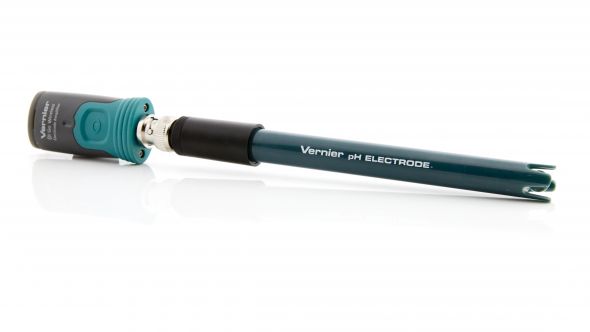These products are no longer available. Information is presented for reference only.
Go Wireless® pH (GW-PH), discontinued

Go Wireless® Electrode Amplifier (GW-EA), discontinued

Hardware & Software Requirements
Go Wireless pH uses Bluetooth low energy technology and can only be used with devices running the appropriate software that support Bluetooth low energy technology.
Troubleshooting
- Primary Test: Press the power button on the sensor to turn it on. (The red LED will be flashing.) Start the data-collection app and select the sensor from the list of available sensors. (The green LED will be flashing.) It should read approximately 4 in its storage solution.
- Secondary Test: Take readings in fresh buffers, NOT distilled water! If no buffers are available, try it in vinegar (~ pH 2.5-3.5) or ammonia (~ pH 10.5-11.5). If readings do not change when the sensor is placed in different solutions, the sensor is possibly defective or damaged.
Additional Troubleshooting
GO WIRELESS OPERATION
- Go Wireless Sensors - Computer, Tablet and Mobile Device Support Details
- Go Wireless Sensors - LabQuest Support Details
- Go Wireless sensors - battery details
- How do I change the name of my Go Wireless sensor?
- Where do I find the serial number and hardware/firmware version numbers of my Go Wireless sensor?
- What do the different LED states mean on a Go Wireless Sensor?
- What does the button do on Go Wireless sensors?
- Go Wireless App Troubleshooting and FAQs
- How do I remove or replace a Go Wireless Temp battery?
- Do Go Wireless products work with computers?
- How do I tell multiple Go Wireless devices apart?
- Where can I use my Go Wireless (not Go Direct) sensors?
pH ELECTRODE OPERATION
- Why doesn't my pH Sensor read pH 7 in distilled or deionized water?
- The glass bulb of my pH Sensor is broken. Can it be repaired?
- The pH electrode I have been using no longer seems to work or is slow to respond. Is there anything I can do to fix it?
- What type of liquids cause problems for the pH Sensor?
- During calibration, what are typical potential readings for the Go Wireless pH Probe?
pH ELECTRODE MAINTENANCE AND STORAGE
- Where do I get pH or ORP Storage Solution? (Buffer Storage Solution)
- What do I do about mold growth in my bottle of pH electrode storage solution?
- How can I keep my pH or ORP storage solution from spilling when the sensor is in use?
- My pH sensors were stored dry. Will they still work?
- What is the best way to clean the glass bulb of the pH electrode?
- Do any of your sensors require special storage?
- I bought your pH buffer capsules. Can I make storage solution for my pH Sensors with this kit?
- How do I dispose of my pH sensor?
Specifications
A Go Wireless pH sensor includes both the Go Wireless Electrode Amplifier and a pH Electrode.
Calibration
Calibrate? Yes. For many experiments, calibrating the pH Sensor is not required. For the most accurate measurements with this sensor, we recommend calibration. It is a simple process that takes only a few minutes.
See Specifications and User Guide for detailed instructions for calibrating using the LabQuest App or Graphical Analysis GW running on a phone or tablet. Calibration from a computer or Chromebook is not supported.
Related Products
- Go Direct® ORP BNC Electrode (GDX-ORP-BNC)
- Go Direct® Charge Station (GDX-CRG)
- Electrode Support (ESUP)
- Stir Station (STIR)
- Go Direct® Drop Counter (GDX-DC)
- Precision Volume Dispenser (DC-DISP)
- Go Direct® pH Sensor (GDX-PH)
Replacement & Maintenance Parts
- Go Direct® pH BNC Electrode (GDX-PH-BNC)
- Go Wireless® 100 mAh Replacement Battery (GW-BAT-100)
- Go Wireless® Charging Cable (GW-CB)
- pH Storage Solution (PH-SS)
- pH Buffer Capsule Kit (PH-BUFCAP)
- Storage Solution Bottles (5) (BTL)
- Go Direct® Electrode Amplifier (GDX-EA)
